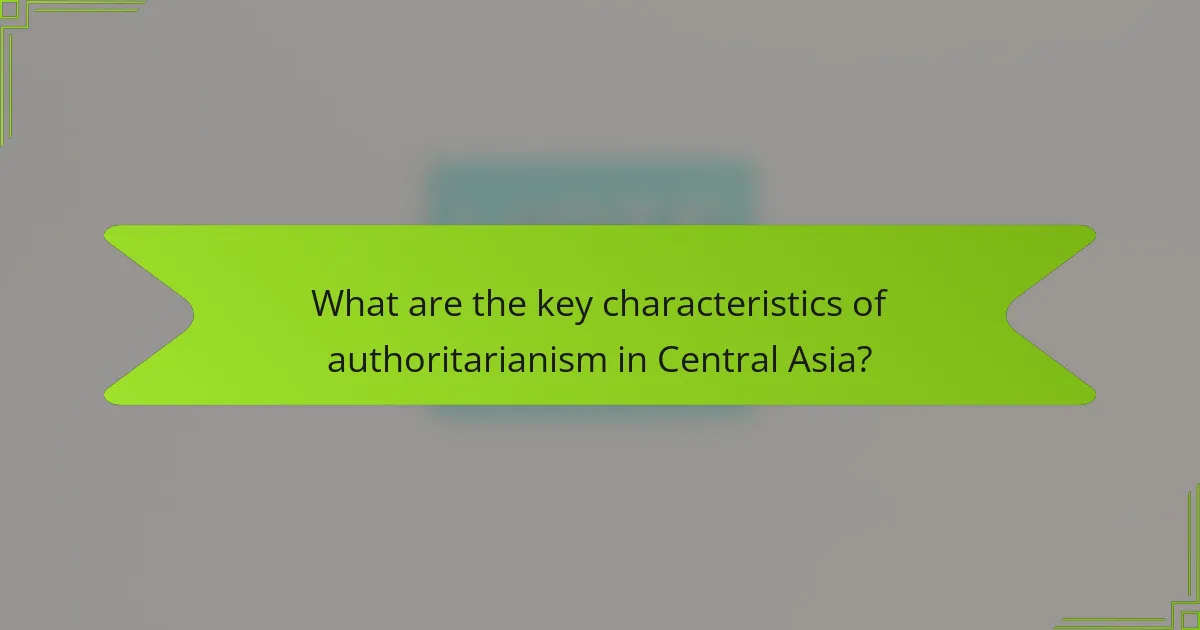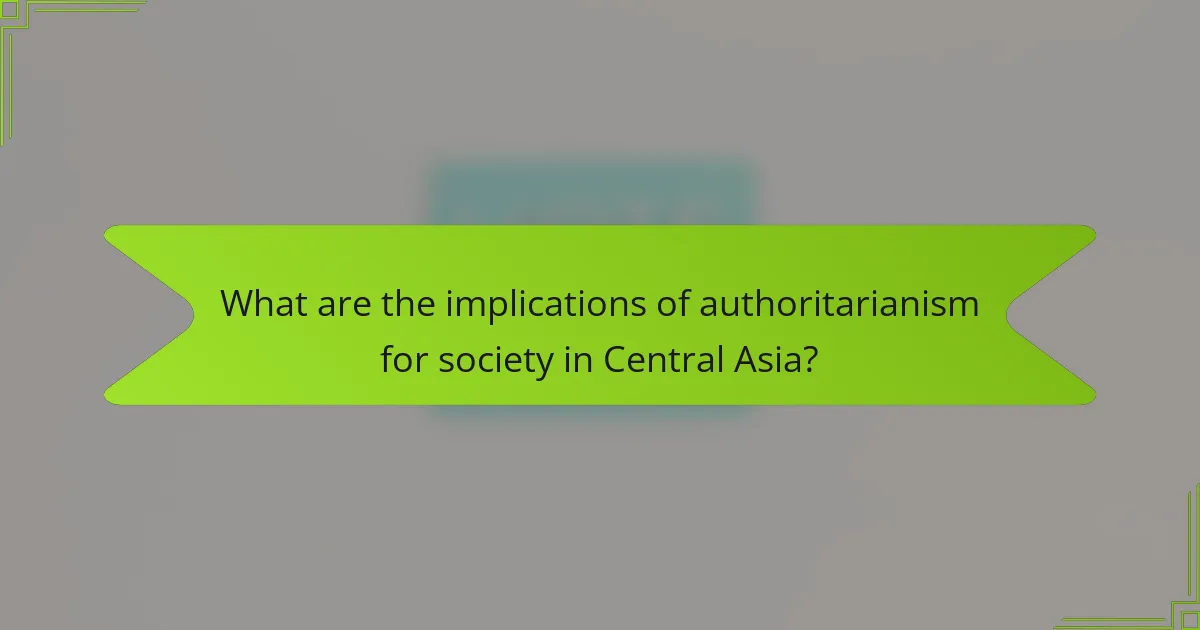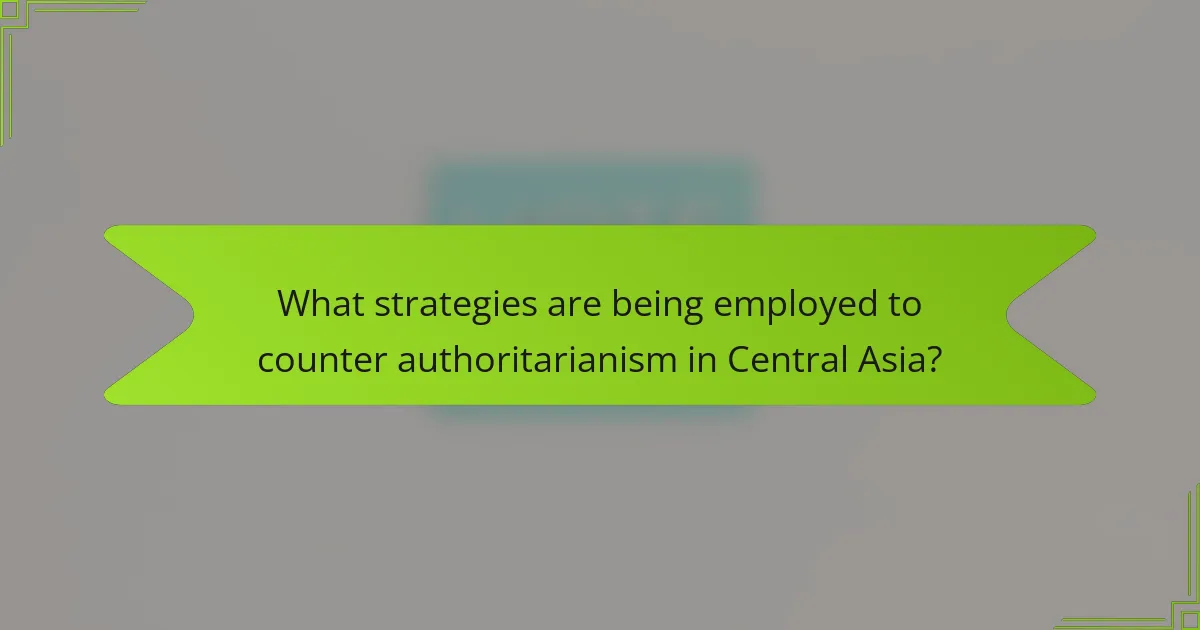This article analyzes the rise of authoritarianism in Central Asia, highlighting key characteristics such as centralized power, limited political pluralism, and suppression of dissent. It discusses the implications of these traits, including human rights abuses, restricted political freedoms, and corruption, which contribute to societal stagnation and inequality. Additionally, the article examines strategies being employed by civil society organizations and grassroots movements to counter authoritarianism, promote democratic governance, and foster political reform. The role of international partnerships and educational initiatives in raising awareness about democratic values is also explored, emphasizing the potential for change in the region.

What are the key characteristics of authoritarianism in Central Asia?
Key characteristics of authoritarianism in Central Asia include centralized power, limited political pluralism, and suppression of dissent. Centralized power is often held by a single leader or ruling party. Limited political pluralism restricts the participation of opposition parties and civil society. Suppression of dissent manifests through censorship, intimidation, and imprisonment of critics. Additionally, state control over media and public discourse is prevalent. Human rights abuses are common, with reports of torture and arbitrary detention. Electoral processes are typically manipulated to ensure the ruling party’s dominance. These characteristics create a political environment that stifles democratic development and civil liberties in the region.
How has authoritarianism evolved in Central Asia over time?
Authoritarianism in Central Asia has evolved significantly since the collapse of the Soviet Union. Initially, newly independent states like Kazakhstan and Uzbekistan faced political instability. Leaders consolidated power to maintain control and prevent chaos. Over time, they established centralized regimes with limited political pluralism.
In the early 2000s, these regimes intensified their authoritarian practices. They restricted media freedom and suppressed dissent. State-controlled narratives became prevalent, shaping public perception. The leaders often justified their actions as necessary for stability and economic development.
Post-2010, authoritarianism adapted to new challenges. Social media emerged as a tool for dissent, prompting governments to enhance surveillance and censorship. Despite occasional protests, regimes remained resilient. The geopolitical landscape, influenced by Russia and China, further entrenched authoritarianism.
Overall, the evolution of authoritarianism in Central Asia reflects a complex interplay of historical, political, and social factors. Each country exhibits unique characteristics, yet common trends of repression and control persist across the region.
What historical events have shaped the current political landscape?
The current political landscape in Central Asia has been shaped by several historical events. The collapse of the Soviet Union in 1991 led to the independence of Central Asian republics. This shift created a power vacuum and allowed for the rise of authoritarian regimes. The subsequent economic challenges fostered instability and reliance on strong leadership. Additionally, the War on Terror post-9/11 influenced regional security policies. The 2010 Kyrgyz revolution highlighted public discontent with authoritarianism. Furthermore, geopolitical interests from Russia and China have impacted political dynamics. These events collectively contribute to the current trend of authoritarianism in the region.
How do cultural factors influence authoritarian regimes in the region?
Cultural factors significantly influence authoritarian regimes in Central Asia. These regimes often leverage cultural narratives to legitimize their rule. National identity plays a crucial role in shaping public perception. Leaders may promote a specific cultural heritage to foster loyalty. Historical grievances are frequently invoked to unify the populace. Traditional values are emphasized to justify repressive measures. Additionally, cultural norms can suppress dissent and discourage opposition. For instance, in Uzbekistan, the government has utilized cultural symbols to reinforce state authority.
What are the main indicators of rising authoritarianism in Central Asia?
The main indicators of rising authoritarianism in Central Asia include the erosion of democratic institutions, suppression of political opposition, and increased state control over media. Erosion of democratic institutions is evident in the manipulation of electoral processes. For instance, several elections in the region have been criticized for lack of transparency and fairness. Suppression of political opposition is marked by the imprisonment of dissenting voices and the banning of opposition parties. Increased state control over media is reflected in government censorship and restrictions on independent journalism. Additionally, there is a growing trend of militarization and the use of security forces to quell protests. These factors collectively illustrate a shift towards more authoritarian governance in Central Asia.
How do political freedoms and civil liberties reflect authoritarian trends?
Political freedoms and civil liberties are indicators of authoritarian trends. In authoritarian regimes, political freedoms are often restricted. This includes limitations on free speech, assembly, and press. Civil liberties, such as the right to privacy and due process, are frequently violated. For example, governments may suppress dissent through censorship or intimidation. The erosion of these freedoms signifies a shift toward authoritarianism. Historical patterns show that as political freedoms decline, authoritarian governance becomes more entrenched. Studies indicate that nations with reduced civil liberties often experience increased state control and repression.
What role do elections play in the context of authoritarian governance?
Elections in authoritarian governance serve primarily as a tool for legitimizing power. They create an illusion of democratic processes while consolidating the regime’s control. Authoritarian leaders often manipulate elections to maintain their authority. This manipulation includes voter suppression, media control, and electoral fraud. For example, in many Central Asian countries, elections are tightly controlled. Observers frequently report irregularities and lack of genuine competition. Such practices ensure that the ruling party remains in power. This strategy helps to project stability and gain international legitimacy. Thus, elections reinforce authoritarian rule rather than promote genuine democratic engagement.

What are the implications of authoritarianism for society in Central Asia?
Authoritarianism in Central Asia leads to limited political freedoms and human rights violations. Citizens often face restrictions on free speech and assembly. Governments maintain tight control over media and public discourse. Corruption is prevalent, undermining trust in institutions. Economic opportunities are often concentrated among elites, widening inequality. Social unrest can arise from repression, leading to protests. Authoritarian regimes may use nationalism to justify their actions. The lack of political competition stifles innovation and reform. These factors contribute to a stagnant society with limited prospects for democratic development.
How does authoritarianism affect economic development in the region?
Authoritarianism negatively affects economic development in the region by stifling innovation and investment. Political repression limits individual freedoms, which can deter entrepreneurship. Centralized control over resources often leads to corruption and misallocation. This creates an environment where economic growth is hampered by inefficiency. Studies show that countries with authoritarian regimes often experience lower GDP growth rates. For example, the World Bank reported that democratic nations tend to attract more foreign direct investment. In contrast, authoritarian regimes may face sanctions that further isolate their economies. Overall, the lack of transparency and accountability under authoritarianism constrains economic progress.
What are the impacts on foreign investment and trade relationships?
The rise of authoritarianism in Central Asia negatively impacts foreign investment and trade relationships. Authoritarian regimes often create an unstable political environment. This instability leads to increased risk for investors. Investors seek stable conditions for their capital. As a result, foreign direct investment may decline. Trade relationships can also suffer due to restrictive policies. Authoritarian governments may impose tariffs and quotas. These measures can hinder free trade agreements. Additionally, lack of transparency can deter foreign businesses. Companies prefer markets with predictable regulations. Overall, authoritarianism can significantly deter foreign investment and disrupt trade relationships.
How does state control over resources influence economic outcomes?
State control over resources significantly influences economic outcomes by determining allocation and distribution. When a government controls resources, it can prioritize sectors that align with its political agenda. This often leads to inefficiencies and corruption, as resources may not be allocated based on market demand. For example, in Central Asia, state control has resulted in distorted pricing and limited competition.
Additionally, state control can stifle private sector growth. When the government monopolizes resources, it reduces opportunities for entrepreneurship. This limits innovation and economic diversification. Historical examples show that countries with heavy state control often experience slower economic growth.
In contrast, nations with more liberal resource management tend to foster competitive markets. This encourages investment and enhances productivity. Thus, the degree of state control over resources plays a crucial role in shaping economic trajectories.
What social consequences arise from authoritarian governance?
Authoritarian governance leads to significant social consequences, including repression of civil liberties. Citizens often experience limited freedom of speech and expression. This suppression results in a lack of political pluralism. Social trust diminishes as the government employs surveillance and censorship. Marginalized groups face increased discrimination and violence. Education systems may promote propaganda over critical thinking. Economic inequality often widens under authoritarian regimes. Studies show that such governance correlates with lower overall life satisfaction among citizens.
How does repression affect public dissent and civil society?
Repression significantly stifles public dissent and weakens civil society. It limits freedom of expression, making it difficult for individuals to voice opposition. This suppression leads to a culture of fear among citizens. Consequently, people may refrain from organizing protests or engaging in activism. Historical examples illustrate this effect. In Uzbekistan, stringent laws restrict public gatherings and independent media. As a result, civil society organizations struggle to operate effectively. The lack of open dialogue further erodes trust between the government and citizens. Overall, repression creates an environment where dissent is dangerous and civil society is marginalized.
What is the relationship between authoritarianism and human rights violations?
Authoritarianism often leads to human rights violations. In authoritarian regimes, power is concentrated in a single leader or a small group. This concentration of power typically suppresses dissent and limits individual freedoms. Governments may use censorship, arbitrary detention, and violence against political opponents. Historical examples include the Soviet Union and North Korea, where state control resulted in widespread abuses. According to Freedom House, countries classified as “not free” experience significantly higher rates of human rights violations. Authoritarianism undermines the rule of law, which is essential for protecting human rights. Thus, the relationship between authoritarianism and human rights violations is direct and well-documented.

What strategies are being employed to counter authoritarianism in Central Asia?
Countries in Central Asia are employing various strategies to counter authoritarianism. Civil society organizations are actively promoting democratic governance and human rights. International partnerships with Western nations are being strengthened to foster political reform. Grassroots movements are emerging, advocating for transparency and accountability. Regional cooperation is also being sought to address common political challenges. Educational programs are raising awareness about democratic values among citizens. Social media campaigns are mobilizing public opinion against oppressive regimes. These strategies aim to empower citizens and encourage political change in the region.
How are grassroots movements responding to authoritarian regimes?
Grassroots movements respond to authoritarian regimes through organized protests, advocacy, and community mobilization. These movements often aim to challenge government policies and demand democratic reforms. They utilize social media to raise awareness and connect supporters. In Central Asia, movements have emerged in response to corruption and human rights abuses. For example, the “Zhanaozen protests” in Kazakhstan in 2011 highlighted labor rights issues against state repression. Additionally, grassroots organizations often collaborate with international NGOs to amplify their messages. This collective action can pressure authoritarian regimes to reconsider their policies. Historical examples show that sustained grassroots efforts can lead to significant political changes.
What role do international organizations play in promoting democracy?
International organizations play a crucial role in promoting democracy. They provide support for democratic governance through funding, training, and expertise. Organizations like the United Nations and the Organization for Security and Co-operation in Europe monitor elections and promote fair practices. They also facilitate dialogue between governments and civil society. These organizations advocate for human rights and the rule of law. Their reports and recommendations influence national policies. In Central Asia, they address challenges to democracy and support reform initiatives. Their involvement helps to raise awareness of democratic values and practices.
How effective are regional coalitions in challenging authoritarian practices?
Regional coalitions are moderately effective in challenging authoritarian practices. They provide a platform for collective action and diplomatic pressure. For example, the Organization for Security and Co-operation in Europe (OSCE) has facilitated dialogue among member states. This has led to increased scrutiny of human rights violations. Additionally, regional coalitions can share resources and strategies. This enhances their capability to address authoritarian regimes. Historical examples include the Arab Spring, where regional solidarity played a role in mobilization. However, effectiveness can vary based on member states’ willingness to cooperate. Some coalitions face internal divisions that limit their impact.
What lessons can be learned from the rise of authoritarianism in Central Asia?
The rise of authoritarianism in Central Asia teaches several lessons about governance and societal resilience. First, it highlights the importance of political institutions in maintaining democracy. Weak institutions can lead to power consolidation by authoritarian leaders. Second, it illustrates the role of economic dependency on a single resource. Countries reliant on oil or gas may face increased authoritarianism during economic downturns. Third, it shows the impact of external influences. Foreign powers can support authoritarian regimes for strategic interests, undermining democratic movements. Fourth, civil society’s strength is crucial. A vibrant civil society can challenge authoritarianism and promote accountability. Lastly, public awareness and education are vital. Informed citizens are better equipped to resist authoritarian practices.
How can other regions apply insights from Central Asia’s experience?
Other regions can apply insights from Central Asia’s experience by analyzing governance patterns. Central Asia has shown that authoritarianism can emerge from weak institutions. By studying these patterns, regions can identify early warning signs. They can also learn about the role of civil society in resisting authoritarianism. The importance of regional cooperation in promoting democracy is evident in Central Asia. Additionally, economic factors influencing governance can be observed. For instance, resource wealth can strengthen authoritarian regimes. Understanding these dynamics enables proactive measures against similar trends elsewhere.
What strategies can be adopted to foster democratic resilience?
Strategies to foster democratic resilience include strengthening civil society, promoting inclusive governance, and enhancing political participation. Strengthening civil society involves supporting non-governmental organizations and grassroots movements. These entities can advocate for democratic values and hold governments accountable. Promoting inclusive governance ensures representation of diverse groups in decision-making processes. This can mitigate feelings of disenfranchisement among marginalized populations. Enhancing political participation encourages citizen engagement through voting and civic education. Increased voter turnout and informed electorates contribute to stronger democracies. Additionally, fostering media freedom allows for independent reporting and public discourse. This transparency can deter authoritarian practices. Supporting international partnerships can also provide resources and frameworks for democratic development. These strategies collectively contribute to a more resilient democratic framework in the face of authoritarian challenges.
What practical steps can citizens take to engage with and challenge authoritarianism?
Citizens can engage with and challenge authoritarianism by participating in peaceful protests. Historical examples show that organized demonstrations can raise awareness and pressure governments. Citizens should also join or support civil society organizations. These organizations often work to promote democracy and human rights. Engaging in community discussions fosters dialogue about governance and accountability. Educating oneself and others about rights is crucial. Knowledge empowers citizens to demand change effectively. Voting in elections is another vital step. Active participation in the electoral process can lead to significant political shifts. Lastly, using social media to share information enhances collective action. This approach can mobilize broader support against authoritarian practices.
The main entity of the article is authoritarianism in Central Asia. The article examines the key characteristics of authoritarian regimes in the region, including centralized power, limited political pluralism, and suppression of dissent. It explores the historical evolution of authoritarianism since the Soviet Union’s collapse, the influence of cultural factors, and the implications for political freedoms, economic development, and human rights. Additionally, it discusses the role of elections, grassroots movements, and international organizations in countering authoritarian practices, while highlighting the lessons learned and strategies for fostering democratic resilience. The article provides a comprehensive analysis of the trends and consequences of authoritarian governance in Central Asia.